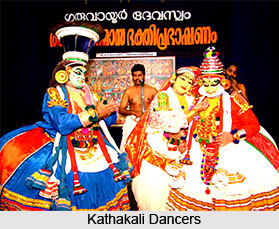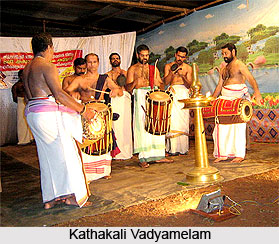 Repertoire in Kathakali borrows heavily from both Mahabharata and Ramayana. Kathakali is generally performed in the evening. It begins with the beating of drums as that plays a key role in creating an atmosphere to perform. The play is performed outside with the light of a single oil-lamp. The beating of drums is done to get the attention of the audience. Dance is combined with dialogue to bring about a life in the myth and legends narrated. In the actual performance, there are three main types of characters: the Satvik which include gods, kings or heroes; the Rajasik, characters with specific vices, such as greed, lust, or vanity; and the Tamasik, the evil characters, such as demons. The basic moral is always the eternal warfare between good and evil.
Repertoire in Kathakali borrows heavily from both Mahabharata and Ramayana. Kathakali is generally performed in the evening. It begins with the beating of drums as that plays a key role in creating an atmosphere to perform. The play is performed outside with the light of a single oil-lamp. The beating of drums is done to get the attention of the audience. Dance is combined with dialogue to bring about a life in the myth and legends narrated. In the actual performance, there are three main types of characters: the Satvik which include gods, kings or heroes; the Rajasik, characters with specific vices, such as greed, lust, or vanity; and the Tamasik, the evil characters, such as demons. The basic moral is always the eternal warfare between good and evil.The playing of the drums or commonly called melappadam is followed by a devotional song called the todayam. Here one or two characters invoke blessings of God. Todayam is performed behind a curtain held by two stage-hands. After that a piece is performed known as the purappadu. Here two characters appear, it is either the hero and his consort, or two other characters who are painted green, or even the Pandavas. The purappadu is a dance of invocation which has no mime. Several dance sequences are performed known as kalasams. Through these cadences the techniques of Kathakali are performed. After this, the play that is chosen for that evening starts.
 There is the slow revelation of the character from behind the curtain before any major character appears. As the curtain gets lowered the character gradually appears. A powerful character when appearing for the first time stands close behind the curtain. The character executes many dance sequences which is accompanied by drums and cymbals and seen by the audience partially. The suspense is maintained. Then the curtain disappears and he appears in his full beauty. The play with curtain is commonly known as tiranokku.
There is the slow revelation of the character from behind the curtain before any major character appears. As the curtain gets lowered the character gradually appears. A powerful character when appearing for the first time stands close behind the curtain. The character executes many dance sequences which is accompanied by drums and cymbals and seen by the audience partially. The suspense is maintained. Then the curtain disappears and he appears in his full beauty. The play with curtain is commonly known as tiranokku.For more, visit the link below: